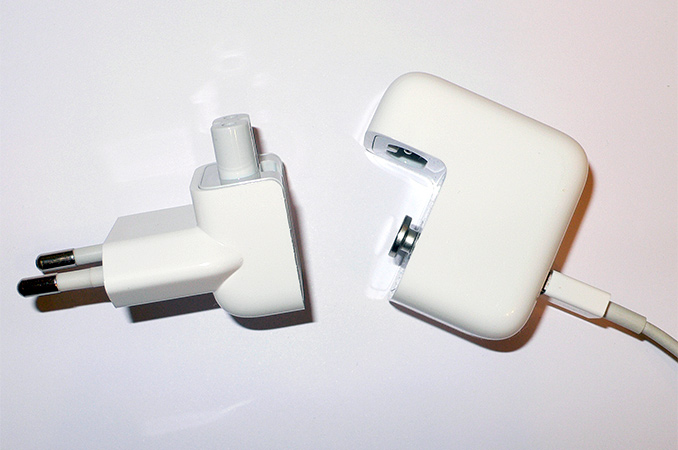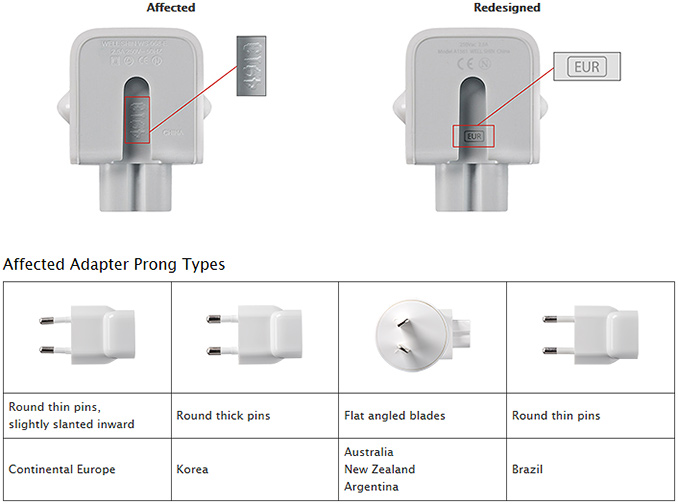Apple Recalls "Duckhead" Power Adapters for Select Mac Laptops and iPads
by Anton Shilov on January 28, 2016 8:00 PM EST
Apple has announced today that they are recalling AC wall plug adapters for its MacBook laptops and iPads in select countries. The issue stems from a design flaw that, if broken, causes the AC plug to pose a risk of electrical shock if touched. The adapters were shipped outside the U.S. from 2003 to 2015 and their total number should be rather huge. Nonetheless, the number of failures known to Apple is limited to 12 cases.
Apple has found that its AC wall plug adapters (AKA "duckheads") designed for use in Continental Europe, Australia, New Zealand, Korea, Argentina and Brazil may malfunction and create a risk of electrical shock if touched. These wall plug adapters were bundled from 2003 to 2015 with Mac PCs as well as iPads. In addition, they were also included in the Apple World Travel Adapter Kit. The company will voluntarily exchange affected wall plug adapters with a new, redesigned model, free of charge.
The affected wall plug adapters have four or five characters or no characters on the inside slot where it attaches to an Apple power adapter. The new wall plug adapters feature a 3-letter regional code in the slot (EUR, KOR, AUS, ARG or BRA). To exchange your device, you should visit a special page at Apple’s web-site.
The Verge reports that Apple is aware of 12 incidents that have occurred around broken adapters in the past 12 years. Details of the incidents are unknown; their exact circumstances are unclear too. From 2003 to 2015, Apple shipped over 120 million Macs and over 230 million iPad. The exact number of devices sold in Europe, Australia, New Zealand, Korea, Argentina and Brazil is uncertain, but it is likely that many tens of millions of AC plug adapters are potentially dangerous. On the other hand, 12 incidents that occurred over 12 years is a miniscule number. Moreover, the vast majority of laptops, smartphones, tablets, phones and players that are more than five years old are no longer in use. Nonetheless, the recall will cost Apple millions of U.S. dollars.
Meanwhile the AC wall plug adapters for the U.S., the U.K., Canada, China, Hong Kong and not part of the recall, which likely indicates that they aren't affected by the underlying issue.
Finally, it should be noted that Apple's AC wall plug adapters are made by contract manufacturers, such as Volex. The same producers make similar devices to other suppliers of consumer electronics.











25 Comments
View All Comments
alin - Saturday, January 30, 2016 - link
OMG! Perfect example of a simple design, made stupidly complex just because "we can". Way to go Apple. Just as always you go the extra mile.Daniel Egger - Sunday, January 31, 2016 - link
I bet you have no idea what you're talking about. Apple basically invented this (completely underestimated) technology of integrating a changeable plug into the power adapter. And it's ingenious for a number of reasons, not only for the users but also Apple and I really wonder why only few other companies (like Microsoft for the Surface) copied it and are in the vast majority producing fugly bricks with a socket for a separate power cord instead.The problem here is that (unlike the US where the prongs are metal and do not (and not have to) provide touch protection) the CEE 7/16 "Euro plug" is required to be made mostly of non-conductive material to provide full touch protection. The usual way to produce those is by moulding and as usual plastic is prone to wearing and tearing when not properly reinforced which is the reason for this recall.
If I had to hazard a guess I'd say that >99% of all produced Euro plugs are prone to the exact same problem, potentially even much worse than the Apple versions (I destroyed at least 4 of them myself by accident, none of them Apple made) since producing in China is all about the price and reinforced plugs don't fit in that picture.
joex4444 - Sunday, January 31, 2016 - link
It's not particularly impressive to have a standardized plug mechanism where it can be sold in multiple different plug styles that just pull off and plug back on. Those "fugly bricks" you mention have the same thing except the "duckhead" is called a "cable" and you just pick up a local one when you want to run your device in a new country. I did this when I moved to Switzerland - just stopped in a local electronics store and bought a new laptop cable with the Swiss plug, cost me all of 10CHF. While there's more than one style of cable, the number of styles is far lower than the number of laptop manufacturers. With Apple, they've always had tight control over their hardware so it's not surprising they can standardize things with themselves.The other nice thing about cables? They take up the least amount of space on a power strip. The duckheads put the power converter right on the strip, how is that possibly a fantastic idea. If you want to avoid that, then you need the cable from Apple and oh look, now you've just bought two things.
Daniel Egger - Sunday, January 31, 2016 - link
> It's not particularly impressive to have a standardized plug mechanism where it can be sold in multiple different plug styles that just pull off and plug back on. Those "fugly bricks" you mention have the same thing except the "duckhead" is called a "cable" and you just pick up a local one when you want to run your device in a new country.Guess what, you can actually connect a regular ungrounded cable to the Apple power bricks as well if you like unwieldy solutions. Everything else you said is true for Apple PSUs as well.
The nice thing about the Apple solution is you can *either* use the duckhead (for a all-in-one ungrounded connection) *or* use the cable and get the little unwieldy but grounded connectivity e.g. for desktop use -- unlike other vendors this will actually also provide proper grounding to the casing.
alexmckay - Tuesday, December 19, 2017 - link
Wow I'm glad my Mac wasn't included in this, I would have never known.